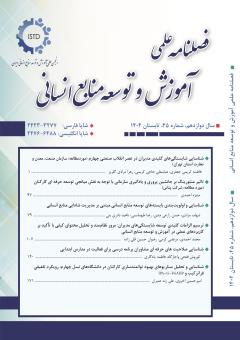شناسایی و اولویت بندی بایسته های توسعه منابع انسانی مبتنی بر مديريت شادابي منابع انسانی
محورهای موضوعی :شهاب مرادی 1 , حسن زارعی متین 2 , رضا طهماسبی 3 , ناهید نادری بنی 4
1 - دانشجوی دكتري مدیریت منابع انسانی، پردیس بین المللی ارس دانشگاه تهران
2 - رئیس دانشکده مدیریت و حسابداری پردیس فارابی و هیئت علمی دانشگاه تهران
3 - پردیس فارابی دانشگاه تهران
4 - دانشگاه تهران، پردیس فارابی
کلید واژه: ابعاد, پیشگیری, شادابی سازمانی, شرکت چاپ و نشر بانک ملّی ایران, عوامل, کنترل.,
چکیده مقاله :
پژوهش حاضر با هدف شناسایی و اولویتبندی عوامل مؤثر بر توسعه منابع انسانی مبتنی بر مدیریت شادابی آنها در شرکت چاپ و نشر بانک ملّی ایران با تأکید بر عوامل کنترل کننده و پیشگیرانه انجام شده است. از لحاظ رویکرد پژوهش، روش آمیخته اکتشافی است. در مرحلهی اول، از روش فرا ترکیب، از روشهای کیفی و در مرحلهی دوم جهت بررسی و اعتباریابی عوامل شناسایی شده و تهیه الگوی نهایی، از روش پیمایشی یعنی نظرسنجی از خبرگان در قالب تشکیل گروههای کانونی و پرسشنامه استفاده شد. جامعه آماری اول، کلیه اسناد مکتوب مربوط به رفتارهای سوء کارکنان در سازمانها و جامعه آماری دوم، خبرگان شرکت در حوزهی مدیریت منابع انسانی بودند. با کاربرد مراحل هفت گانه فراترکیب، الگوی مفهومی در شش لایه و در هر لایه مفاهیم و موضوعاتی گنجانده که در نهایت 29 مؤلفه شناسایی شد. در نتیجه ابعاد اصلی اثرگذار بر کنترل و پیشگیری رفتارهای سوء کارکنان و شادابی سازمانی: عوامل راهبردی و سیاستی، توسعه منابع انسانی، توسعه فردی، مدیریت، مشارکت و محیطی مشخص شدند. الگوی مفهومی حاصل، میتواند مبنای پژوهشهای آتی جهت هدایت، راهبری و رفتارشناسی کارکنان به منظور ارائه راهبردها و سیاستهای اجرایی برای مسئولین و تصمیمگیران سازمانها و نهادهای ذی نقش، جهت کنترل و پیشگیری از رفتارهای سوء کارکنان قرار گیرد.
The present study seeks to identify and prioritize the factors influencing human resource development through happiness management in the Printing and Publishing Company of the National Bank of Iran, with an emphasis on controlling and preventive factors. In terms of methodology, the research employed a mixed exploratory approach. In the first phase, a meta-synthesis method was utilized, considered as a qualitative method. In the second phase, a survey method was applied to examine and validate the identified factors and construct the final model. This involved a survey of experts in the form of forming focus groups and questionnaires. The study corpus comprised documented studies related to employee misconduct in organizations, and the second statistical population was the company's experts in the field of human resource management. Through Application of seven stages of meta-synthesis, a six-layer conceptual model was developed, and each layer included concepts and topics, encompassing 29 components. As a result, the main dimensions affecting the control and prevention of employee misconduct and organizational happiness were determined: strategic and political factors, human resource development, individual development, management, participation, and environment. The proposed conceptual provides a foundation for future research on guidance, management, and employee behavior in order to offer executive strategies and policies for officials and policymakers of organizations and institutions involved in controlling and preventing employee misconduct.
